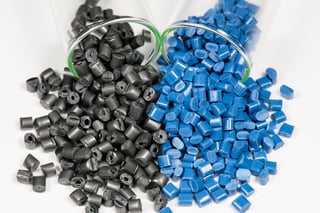Nylons are semi-crystalline resins with a very low viscosity at melting point, excellent chemical resistance, good temperature resistance, and good toughness (moisture). There are 8 types of nylons: Nylon 6; Nylon 6,6; Nylon 4,6; Nylon 6,9; Nylon 6,10; Nylon 6,12; Nylon 11; and Nylon 12.
Nylon 6 vs. Nylon 6,6
While Nylon 6 and Nylon 6,6 are interchangeable in about 80% of nylon resin applications, for the other 20% of applications, the differences between them are important, as shown in this table below.
Property Dry, As Molded 50% Relative Humidity
|
Nylon 6 |
Nylon 6,6 |
Nylon 6 |
Nylon 6,6 |
|
|
Tensile strength (psi) |
11,800 |
12,000 |
7,000 |
8,500 |
|
Flex mod (psi) |
390,000 |
420,000 |
150,000 |
175,000 |
|
Izod impact (ft-lb/in) |
1.1 |
1.0 |
4.0 |
2.1 |
|
Drop weight impact (ft-lb) |
100 |
75 |
160 |
100 |
As water is absorbed, stiffness will decrease as toughness increases. It could take one year to reach 2.5% moisture at 50% relative humidity depending on part thickness. For ever 1% water absorbed, the size increases by approximately .003 in/in (.3%). The rate and the amount of water absorption will depend on wall thickness, relative humidity, and compound composition.

The chemical structure between Nylon 6 and Nylon 6,6 based on properties is as follows:
|
Nylon 6 |
Nylon 6,6 |
|
|
Melting Point C |
220 |
260 |
|
Sp Gravity |
1.14 |
1.14 |
|
Crystallization Rate |
|
|
|
Moisture Abs @ Equil (5) |
|
|
Unreinforced Nylon 6 and Nylon 6,6 are comparable in surface smoothness and gloss. Nylon 6 performs better in both counts in glass reinforced grades because of Nylon 6’s lower melting point and slower crystal growth during cooling. If it stays molten longer leaves more time for capillary action to drive reinforcing fibers away from the surface and back into material leaving a smoother surface. Nylon 6 is chosen most often for office furniture, appliances, power-tool housings, or anywhere where appearances are important.
Notable attributes of Nylon 6
- The tendency of Nylon 6 to solidify more slowly provides the extra time needed for complete filling of large cavities.
- At the processor level, Nylon 6 retains its properties through regrinding and remelting much better than does Nylon 6,6.
- Nylon 6 retains more than 90% of its toughness after 4 regrind cycles, while Nylon 6,6 loses more than 90%.
Stay tuned for our next blog in this series where we will differentiate Nylon Nylon 4,6, Nylon 11, and Nylon 12 from the nylons above.


